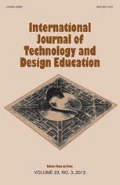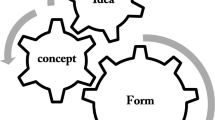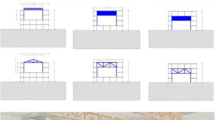Abstract
Digital design and fabrication tools obtain constraints affecting creativity in conceptual design phase. There is a necessity to have a better understanding of issues related to the rationalization process of form, material and fabrication. The objective of this paper is to integrate analogue craft into architectural design studio that can be applicable into various educational setups, in order to increase the algorithmic thinking skills of students, before giving tutorials on the software tools and digital fabrication techniques. The Rule-based Rationalization of Form (RRF) was implemented as a task for a mobile unit design through computational making. The research methodology of RRF consists of four stages, including specifying the design constraints and the rules; the design of the components and the overall form; making the large-scale mock-up; and process evaluation. It was implemented to the second year undergraduate architectural design studios from Fall 2014 to 2016. The data were collected by the process analysis and questionnaire applied to the participants. The output studies were grouped in three, as Modular, Folding and Biomimetic design systems, based on the geometrical characteristics and organizational principles applied in the process. In the light of research objective, algorithmic thinking skills of students were developed through analogue craft, as well as participants obtained a better understanding of issues related to the rationalization process of form, material and fabrication, by testing relationships between the geometry, tools and the materials.







Similar content being viewed by others
References
Alberti, L. B. (1988). On the art of building in ten books. Cambridge: MIT Press.
Attar, R., Aish, R., Stam, J., Brinsmead, D., Tessier, A., Gluek, M., et al. (2010). Embedded rationality: A unified simulation framework for interactive form finding. International Journal of Architectural Computing,8(4), 399–418.
Bell, L. (2009). Air supported membrane structure applications for large-scale disaster response shelters. International Journal of Space Structures,24(4), 233–236.
Boza, L. E. (2006). (Un)Intended discoveries: Crafting the design process. Journal of Architectural Education,60, 4–7.
Brugnaro, G., Baharlou, E., Vasey, L., & Menges, A. (2016) Robotic softness: An adaptive robotic fabrication process for woven structures. In: 36th the association for computer aided design in architecture (ACADIA) conference proceedings, Ann Arbor (pp. 154–163).
Celani, G. (2012). Digital fabrication laboratories: Pedagogy and impacts on architectural education. Nexus Network Journal,14(3), 469–482.
Cennamo, C., Cennamo, G. M., & Chiaia, B. M. (2012). Robustness-oriented design of a panel-based shelter system in critical sites. Journal of Architectural Engineering,18(2), 123–139.
Chiarella, M., & Alvarado, R. G. (2015). Folded compositions in architecture: Spatial properties and materials. Nexus Network Journal,17, 623–639.
Cross, N. (1982). Designerly ways of knowing. Design Studies,3(4), 221–227.
Cuff, D. (1991). Architecture: The story of practice. Cambridge: MIT Press.
Datta, S., Sharman, M., & Chang, T. (2016). Computation and fabrication of scaled large-scale mockups. Automation in Construction,72, 26–32.
Dewey, J. (1997). Experience and education. New York: Touchstone. (first published in 1938).
El-Zanfaly, D. (2015). Imitation, iteration and improvisation: Embodied interaction in making and learning. Design Studies,41, 79–109.
Fischer, T. (2007). Enablement or restriction? In 12th international aided architectural design futures conference. Sydney (pp. 585–598).
Harris, J. (2016). On the buses: Mobile architecture in Australia and the UK, 1973–75. Architectural Histories,4(1), 1–14.
Holzer, D., & Downing, S. (2008) The role of architectural geometry in performance-orientated design. In Proceedings of advances in architectural geometry, Vienna (pp. 99–102).
Jordan, T. P. (2012). Digital craft: Refabricating digital to analog design methodologies. Master thesis. University of Cincinnati.
Karppinen, S., Kallunki, V., & Komulainen, K. (2017). Interdisciplinary craft designing and invention pedagogy in teacher education: student teachers creating smart textiles. International Journal of Technology and Design Education,29, 1–18.
Knight, T., & Stiny, G. (2015). Making grammars: From computing with shapes to computing with things. Design Studies,41(Part A), 8–28.
Knight, T., & Vardouli, T. (2015). Computational making. Design Studies,41(Part A), 1–7.
Kolarevic, B. (2008). The (risky) craft of digital making. In B. Kolarevic & K. Klinger (Eds.), Manufacturing material effects: Rethinking design and making in architecture (pp. 119–128). London: Routledge.
Kolb, D. A. (1984). Experiential learning: Experience as the Source of Learning and Development. New Jersey: Prentice Hall.
Krieg, O. D., Mihaylov, B., Schwinn, T., Reichert, S., & Menges, A. (2012). Computational design of robotically manufactured plate structures based on biomimetic design principles derived from clypeasteroida, digital physicality. In 30th education and research in computer aided architectural design in europe (eCAADe) conference proceedings (pp. 531–540). Prague.
Kronenburg, R. (2002). Preface by Robert Kronenburg. In J. Siegal (Ed.), Mobile: The art of portable architecture (pp. 12–15). New York: Princeton Architectural Press.
Kvan, T., Mark, E., Oxman R., & Martens, B. (2004). Ditching the dinosaur: Redefining the role of digital media in education. International Journal of Design Computing, 7.
Loh, P., Burry, J., & Wagenfeld, M. (2016). Reconsidering Pye’s theory of making through digital craft practice: A theoretical framework towards continuous designing. Craft Research,7(2), 187–206.
Lyon, A., & Garcia, R. (2011). Interlocking, ribbing and folding: Explorations in parametric constructions. Nexus Network Journal,13(1), 221–234.
Marda, N. (1997). ‘Visual design thinking’ Stoa, European Association for Architectural Education No. 2, November.
Mark, E., Martens, B., & Oxman, R. (2003). Preliminary stages of CAAD education. Automation in Construction,12(6), 661–670.
McCullough, M. (1996). Abstracting craft: The practiced digital hand. Cambridge: MIT.
Megahed, N. A. (2013). Towards math-based architectural education in egyptian engineering faculties. Nexus Network Journal,15(3), 565–581.
Moholy-Nagy, L. (2005). The new vision: Fundamentals of bauhaus design, painting, sculpture, and architecture. Mineola: Dover Publications.
Oxman, R. (1999). Educating the designerly thinker. Design Studies,20, 105–122.
Oxman, R. (2004). Think-maps: teaching design thinking in design education. Design Studies,25, 63–91.
Oxman, R. (2017). Thinking difference: Theories and models of parametric design thinking. Design Studies,52(2017), 4–39.
Ozkar, M. (2007). Learning by doing in the age of design computation. In Proceedings of the 12th international conference on computer aided architectural design futures (pp. 99–112).
Paio, A., Eloy, S., Rato, V. M., Resende, R., & Oliveira, M. J. (2012). Prototyping vitruvius, new challenges: Digital education, research and practice. Nexus Network Journal,14(3), 409–429.
Pottmann, H., Schiftner, A., & Wallner, J. (2008). Geometry of architectural freeform structures. Internationale Mathematische Nachrichten,209, 15–28.
Pye, D. (1978). The nature and art of craftmanship. London: Cambridge University Press.
Roke, R. (2010). Bits and pieces: Crafting architecture in a post-digital age. Master thesis. RMIT.
Schon, D. (1983). The reflective practitioner. New York: Basic Books.
Schon, D. A. (1988). Designing: Rules, types and worlds. Design Studies,9, 181–190.
Schon, D. A., & Wiggins, G. (1992). Kinds of seeing and their functions in designing. Design Studies,13, 135–156.
Siegal, J. (2002). In J. Siegal (Ed.), Mobile: The art of portable architecture (pp. 16–27). New York: Princeton Architectural Press.
Simon, H. A. (1996). The sciences of the artificial. Cambridge: MIT Press.
Stiny, G. (1980). Kindergarten grammars: Designing with Froebel’s gifts. Environment and Planning B,7, 409–462.
Stiny, G. (2011). What rule(s) should I use? Nexus Network Journal,13(1), 15–47.
Terzidis, K. (2006). Algorithmic architecture. Oxford: Elsevier.
Yazici, S. (2011). Computing through holistic systems design method: Material formations workshop. Dearq Journal of Architecture,9, 90–101.
Zaman, C. H., Ozkar, M., & Cagdas, G. (2011). Towards hands-on computing in design: An analysis of the haptic dimension of model making. METU Journal of Architecture,28(2), 209–226.
Acknowledgements
The studies were undertaken at Ozyegin University Faculty of Architecture and Design in Istanbul from Fall 2014 to Fall 2016. The student names of the featured work are Asem Sallam, Elif Kaya, Yaren Aslan, Ayse Ozlem Dal, Eda Fer, Ece Tunca, Didem Bozdemir, Ipek Duysak, Ecem Taskin, Tugce Caner, Egenur Corlu, Ecenur Corlu, Sena Ozgurcan, Enis Tan Ulman, Edanur Ozbayraktar, Atilla Mert Cukaci and Asli Suberker.
Author information
Authors and Affiliations
Corresponding author
Additional information
Publisher's Note
Springer Nature remains neutral with regard to jurisdictional claims in published maps and institutional affiliations.
Rights and permissions
About this article
Cite this article
Yazici, S. Rule-based rationalization of form: learning by computational making. Int J Technol Des Educ 30, 613–633 (2020). https://doi.org/10.1007/s10798-019-09509-5
Accepted:
Published:
Issue Date:
DOI: https://doi.org/10.1007/s10798-019-09509-5




